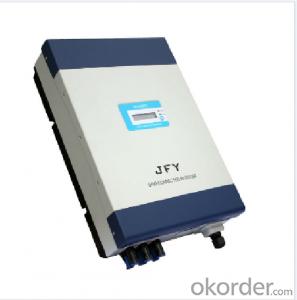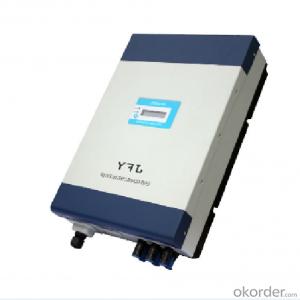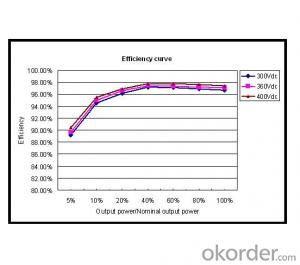PV Grid-Tied 5kw Solar Inverter JSI-5000TL
- Loading Port:
- Qingdao
- Payment Terms:
- TT OR LC
- Min Order Qty:
- 50000 watt
- Supply Capability:
- 3000000 watt/month
OKorder Service Pledge
OKorder Financial Service
You Might Also Like
1. Structure of PV Grid-Tied 5kw Solar Inverter JSI-5000TL Description
1.High Efficiency 97.6%
2.5 Year warranty
3.Transformerless, pure sine wave
4.TUV,VDE,CE,SAA,CEI0-21
2. Main Features of thePV Grid-Tied 5kw Solar Inverter JSI-5000TL Inverter
﹒Compact size, easy installation &maintenance;
﹒Low running noise, highest efficiency;
﹒Wide operating temperature range
﹒At least 5 years warranty
﹒High Quality ,competitive price
﹒TUV, CE, AS4777, G59/2 Certificate
3. PV Grid-Tied 5kw Solar Inverter JSI-5000TL Images




4. PV Grid-Tied 5kw Solar Inverter JSI-5000TL Specification
CHARACTERISTICS | JSI-5000TL |
Input Data(DC side) | |
Max. DC power | 5300W |
Max. DC voltage | 550Vdc |
MPPT Operating range | 100~500Vdc |
Number of parallel inputs | 3 |
Number of MPPT trackers | 1 |
Max. input current (total) | 22.5A |
Output Data(AC side) | |
Nominal output power | 4600W |
Max. Output power | 5000W |
Nominal output current | 20A |
Max. output current | 24A |
Nominal AC voltage | 230Vac |
Possible AC voltage range * | 190~265Vac |
Nominal AC grid frequency | 50Hz |
Possible AC grid frequency range* | 50 ± 5 Hz |
Power factor(cos φ) | >0.99 |
Harmonic distortion(THDI) | <3%(at nominal output power) |
Efficiency | |
Max. efficiency | 97.6% |
Euro efficiency | 97% |
MPPT efficiency | 99.6% |
Genaral data | |
Dimensions (W / D / H) | 345*152*505mm |
Net weight | 23.7Kg |
Operating temperature range | –25 °C ~ +60 °C |
Noise emission (typical) | ≤ 25 dB(A) |
Power consumption at night | 0 W |
Electrical isolation | Transformer-less |
Cooling concept | Natural cooling |
IP Code | IP65 |
Communication | RS-485/RS-232 |
5. FAQ of PV Grid-Tied 5kw Solar Inverter JSI-5000TL
Q1. What is the difference between inverter and solar inverter?
A1. Inverter only has AC inpput, but solar inverter both connect to AC input and solar panel, it saves more power.
Q2. What is the difference between MPPT&PWM?
A2. MPPT has higher efficiency, it can track the max power point and won't waste energy.
Q3. What is the waranty of product?
A3. 12 months.
- Q:How does a solar inverter impact the payback period of a solar system?
- A solar inverter can have a significant impact on the payback period of a solar system. The efficiency and reliability of a solar inverter can affect the overall energy production and performance of the solar system. A high-quality inverter can optimize the conversion of solar energy into usable electricity, maximizing the system's output and reducing energy losses. This improved efficiency can shorten the payback period by increasing the amount of electricity generated and therefore the savings on utility bills. Additionally, a reliable inverter can minimize maintenance and replacement costs, further enhancing the financial returns of the solar investment.
- Q:What is the maximum AC voltage that a solar inverter can provide?
- The maximum AC voltage that a solar inverter can provide typically depends on the specific model and its specifications. However, most residential and commercial solar inverters provide a maximum AC voltage output of around 240 volts or 480 volts, depending on the electrical grid requirements and system configurations.
- Q:How does a solar inverter handle voltage drop in long cable runs?
- A solar inverter compensates for voltage drop in long cable runs by using a technology called Maximum Power Point Tracking (MPPT). MPPT allows the inverter to continuously adjust the operating voltage and current to extract the maximum power from the solar panels. This ensures that even with voltage drop in long cable runs, the inverter optimizes the power output from the panels, ultimately minimizing the impact of the voltage drop.
- Q:What are the different types of solar inverters?
- There are three main types of solar inverters: string inverters, microinverters, and power optimizers.
- Q:Can a solar inverter be used in harsh environmental conditions?
- A solar inverter is capable of operating in harsh environmental conditions. It can withstand a wide range of environmental factors, including extreme temperatures, humidity, dust, and vibrations. Manufacturers often construct solar inverters using durable materials and apply protective coatings to shield them from severe weather conditions. Furthermore, many solar inverters are equipped with advanced cooling mechanisms to prevent overheating in hot climates. Nevertheless, it is crucial to consider that the durability and performance of a solar inverter in harsh conditions may differ depending on the brand and model. To guarantee optimal performance and longevity, it is advised to select a reliable and high-quality solar inverter specifically designed for use in harsh environmental conditions.
- Q:How much maintenance is required for a solar inverter?
- Solar inverters require regular maintenance to ensure optimal performance and longevity. The frequency and level of maintenance may vary depending on the specific make and model of the inverter, as well as environmental factors. Generally, maintenance tasks include regular cleaning to remove dust and debris, checking and tightening electrical connections, inspecting for any signs of wear or damage, and updating software or firmware as needed. It is recommended to follow the manufacturer's guidelines and have a professional solar technician perform periodic maintenance to maximize the efficiency and reliability of the solar inverter.
- Q:Can a solar inverter be used with a generator as a backup power source?
- Yes, a solar inverter can be used with a generator as a backup power source. The solar inverter can be connected to the generator's power output, allowing it to convert the generator's AC power into usable DC power for the solar panels. This enables the solar panels to continue generating electricity even when there is no sunlight, providing a reliable backup power supply.
- Q:Can a solar inverter be used with a solar-powered backup generator?
- Yes, a solar inverter can be used with a solar-powered backup generator. The solar inverter is responsible for converting the direct current (DC) generated by the solar panels into alternating current (AC) that can be used to power household appliances and electrical devices. When connected to a solar-powered backup generator, the solar inverter can efficiently regulate and distribute the electricity produced by the generator, providing a reliable and sustainable source of power.
- Q:Can a solar inverter be integrated with energy management systems?
- Yes, a solar inverter can be integrated with energy management systems. In fact, many modern solar inverters are designed to be compatible with energy management systems, allowing for better monitoring, control, and optimization of the energy generated by the solar panels. This integration enables users to track their energy production, consumption, and storage, and make informed decisions on energy usage to maximize efficiency and cost savings.
- Q:How does a solar inverter handle voltage flicker?
- A solar inverter handles voltage flicker by constantly monitoring the grid voltage and adjusting its output to maintain a stable voltage. It uses advanced control algorithms to quickly respond to fluctuations and minimize the impact of voltage flicker on the connected devices.
1. Manufacturer Overview |
|
|---|---|
| Location | |
| Year Established | |
| Annual Output Value | |
| Main Markets | |
| Company Certifications | |
2. Manufacturer Certificates |
|
|---|---|
| a) Certification Name | |
| Range | |
| Reference | |
| Validity Period | |
3. Manufacturer Capability |
|
|---|---|
| a)Trade Capacity | |
| Nearest Port | |
| Export Percentage | |
| No.of Employees in Trade Department | |
| Language Spoken: | |
| b)Factory Information | |
| Factory Size: | |
| No. of Production Lines | |
| Contract Manufacturing | |
| Product Price Range | |
Send your message to us
PV Grid-Tied 5kw Solar Inverter JSI-5000TL
- Loading Port:
- Qingdao
- Payment Terms:
- TT OR LC
- Min Order Qty:
- 50000 watt
- Supply Capability:
- 3000000 watt/month
OKorder Service Pledge
OKorder Financial Service
Similar products
New products
Hot products
Hot Searches
Related keywords































